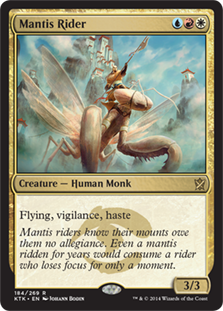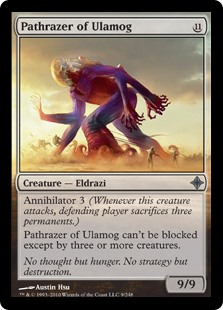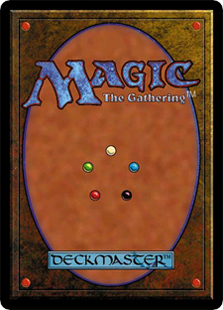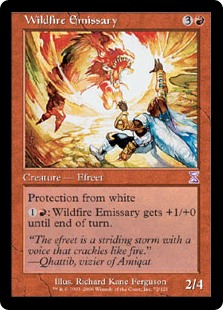Is there an OK guide out there of what power level a creature/instant/sorcery should be based on what CMC it's at? Then you have cards that need multicolors or all one color which seems to power up creatures for their CMC.
I've read somewhere that after a certain threshold (5, 6 mana?) a creature should just get way more powerful because you're unlikely to be putting down a land every turn at that point in the game.
For vanilla creatures some of the best ones are...
0: 1/1 Memnite
1: 2/1 Savannah Lion
2: 3/3 Watchwolf (multicolored)
3: 4/5 Leatherback Baloth (all green mana)
3: 5/4 Wooly Throctar (3 colors)
4: 2/10 Indomitable ancients
5: 8/8 Fusion Elemental 8/8 (5 colors)
6: 7/7 Vorstclaw
7+: ???
The effectiveness of a creature is ultimately dependent on what combos are available in the rotation but I figure getting down the vanilla creature curve is a start
MTG's mana curve
Moderator: Moderators
- OgreBattle
- King
- Posts: 6820
- Joined: Sat Sep 03, 2011 9:33 am
MTG's mana curve
Last edited by OgreBattle on Fri Sep 04, 2015 4:57 am, edited 4 times in total.
-
Username17
- Serious Badass
- Posts: 29894
- Joined: Fri Mar 07, 2008 7:54 pm
What a good mana curve looks like is entirely format dependent. Different environments will be different speeds and the reliability and quantity of mana is going to be wildly different in different formats as well.
So let's consider the Tarkir block for a moment. It has three color lands in it whose only drawback is that they come in to play tapped. So it has all-star creatures that cost three different colors of mana (the Mantis Rider, Anafenza, and the Siege Rhino). Paying three or four mana for a creature but having to come up with 3 different flavors of mana is considered acceptable because players can do it easily using the lands they have (they aren't even rare, the Tarkir wedge lands are uncommons and the Tarkir life lands are commons).


You can run the card on the left because you are using the card on the right.
But the new block is going to be Zendikar. In Zendikar people take Eldrazi seriously. They cost a shit tonne of mana, but that's OK because the Eldrazi faction spawns a crap load of shitty little token creatures that they can eat for colorless mana.


You can run the card on the left because you have access to piles of the token on the right.
There are formats where fast creatures and brutal ramping means that anything you can't put into play before turn 5 basically doesn't matter. There are formats where harsh removal and good defenses mean that creatures only really matter if you are getting value for them coming into/leaving play or they have hexproof and costs aren't really a big concern.
Cards are only good or bad relative to their environment. There are cards like Timewalk that are so powerful that it's unlikely that there will ever be an environment where they are not overpowered. But creatures almost never fit that description. Both the Mantis Rider and the Eldrazi would be unplayable in a two-color format that topped out at 5 mana cost. But in the formats they actually live in, they do fine.
-Username17
So let's consider the Tarkir block for a moment. It has three color lands in it whose only drawback is that they come in to play tapped. So it has all-star creatures that cost three different colors of mana (the Mantis Rider, Anafenza, and the Siege Rhino). Paying three or four mana for a creature but having to come up with 3 different flavors of mana is considered acceptable because players can do it easily using the lands they have (they aren't even rare, the Tarkir wedge lands are uncommons and the Tarkir life lands are commons).
You can run the card on the left because you are using the card on the right.
But the new block is going to be Zendikar. In Zendikar people take Eldrazi seriously. They cost a shit tonne of mana, but that's OK because the Eldrazi faction spawns a crap load of shitty little token creatures that they can eat for colorless mana.
You can run the card on the left because you have access to piles of the token on the right.
There are formats where fast creatures and brutal ramping means that anything you can't put into play before turn 5 basically doesn't matter. There are formats where harsh removal and good defenses mean that creatures only really matter if you are getting value for them coming into/leaving play or they have hexproof and costs aren't really a big concern.
Cards are only good or bad relative to their environment. There are cards like Timewalk that are so powerful that it's unlikely that there will ever be an environment where they are not overpowered. But creatures almost never fit that description. Both the Mantis Rider and the Eldrazi would be unplayable in a two-color format that topped out at 5 mana cost. But in the formats they actually live in, they do fine.
-Username17
- Josh_Kablack
- King
- Posts: 5318
- Joined: Fri Mar 07, 2008 7:54 pm
- Location: Online. duh
Mana curve is only part of what makes a creature worthwhile in an environment.
Creatures are both competing against direct damage spells for efficiency and also measured in terms of their resistance against direct damage and creature removal effects.
The original core set had Lightning Bolt, Fireball, Drain Life and Disintegrate, all as commons. Going beyond core set commons gave you Hurricane, Earthquake, Psionic Blast, Fork, Chain Lightning, Land's Edge, Pyrotechnics, Psychic Purge, Ball Lightning (technically a creature), Incinerate Lava Burst, Meteor Shower, Flare, Stormbind, Touch of Death, Karavek's Torch, Scorching Lava, Hammer of Bogardan and more I'm am forgetting or never cared about. It was for a while tournament acceptable, if not tournament-winning to run a deck with nothing but mana accelerators, card accelerators and direct damage spells. This generally kept pace with even the fastest of rush creature decks and was less vulnerable to mana screw and removal spells (if more vulnerable to counterspell, land destruction and CoP: Red)
In addition to the above damage spells, the original set included Terror, Paralyze and Unsummon as commons with Swords to Plowshares, Icy Manupulator, Meekstone and Control Magic as uncommon well as rermove-all effects like Wrath of God, Balance, and Nevinyrral's Disk at rare. Very quickly additional anti-creature things like Oubliette, Horn of Deafening, Weakstone, Boomerang, The Abyss, Moat, Maze of Ith and more got printed.
All of this made spending 5 mana on a creature a pretty risky proposition, since opponents were likely to have an answer for 1 or 2 mana, or an answer a 4 mana that also gave them card advantage, or they could spend the same 5 mana to deal 4 damage to you without the 1-turn delay that your 5-cost creature had. Thus the early meta was largely dominated by creatures that were either very cheap (Kurd Ape, Elvish Archer, Savannah Lion) or immune to one or more of the cheap removal tools. Serra Angels were worth it at 5 as they had toughness greater than Lightning Bolt, were immune to Meekstone resistant to Paralyze and could both attack and block in a turn. Vampires were worth at at 5, as they had toughness greater than Lightning Bolt and were immune to Terror. Hypno Spector was only immune to Terror, but it was cheap enough to be a turn 1 drop in many decks and the card advantage from a hit was enough to swing games. Juggernaut was similar at casting cost 4 - you expected your opponent to have an answer, but if they somehow didn't have an answer right now, the 5 damage hit was often enough for a rush deck to win.
Even the mishra's factories, knights, pump kinights, serendib effreets, ernham and juzam djinns, commonly seen as quick and cheap cannon fodder, were not merely mana-efficient, but were also immune to at least one of the early removal tools.

In Mirage-only, this being immune to the most efficient red and while removal spells in Mirage made it a tournament staple, but nobody cared about it in more open formats
Creatures are both competing against direct damage spells for efficiency and also measured in terms of their resistance against direct damage and creature removal effects.
The original core set had Lightning Bolt, Fireball, Drain Life and Disintegrate, all as commons. Going beyond core set commons gave you Hurricane, Earthquake, Psionic Blast, Fork, Chain Lightning, Land's Edge, Pyrotechnics, Psychic Purge, Ball Lightning (technically a creature), Incinerate Lava Burst, Meteor Shower, Flare, Stormbind, Touch of Death, Karavek's Torch, Scorching Lava, Hammer of Bogardan and more I'm am forgetting or never cared about. It was for a while tournament acceptable, if not tournament-winning to run a deck with nothing but mana accelerators, card accelerators and direct damage spells. This generally kept pace with even the fastest of rush creature decks and was less vulnerable to mana screw and removal spells (if more vulnerable to counterspell, land destruction and CoP: Red)
In addition to the above damage spells, the original set included Terror, Paralyze and Unsummon as commons with Swords to Plowshares, Icy Manupulator, Meekstone and Control Magic as uncommon well as rermove-all effects like Wrath of God, Balance, and Nevinyrral's Disk at rare. Very quickly additional anti-creature things like Oubliette, Horn of Deafening, Weakstone, Boomerang, The Abyss, Moat, Maze of Ith and more got printed.
All of this made spending 5 mana on a creature a pretty risky proposition, since opponents were likely to have an answer for 1 or 2 mana, or an answer a 4 mana that also gave them card advantage, or they could spend the same 5 mana to deal 4 damage to you without the 1-turn delay that your 5-cost creature had. Thus the early meta was largely dominated by creatures that were either very cheap (Kurd Ape, Elvish Archer, Savannah Lion) or immune to one or more of the cheap removal tools. Serra Angels were worth it at 5 as they had toughness greater than Lightning Bolt, were immune to Meekstone resistant to Paralyze and could both attack and block in a turn. Vampires were worth at at 5, as they had toughness greater than Lightning Bolt and were immune to Terror. Hypno Spector was only immune to Terror, but it was cheap enough to be a turn 1 drop in many decks and the card advantage from a hit was enough to swing games. Juggernaut was similar at casting cost 4 - you expected your opponent to have an answer, but if they somehow didn't have an answer right now, the 5 damage hit was often enough for a rush deck to win.
Even the mishra's factories, knights, pump kinights, serendib effreets, ernham and juzam djinns, commonly seen as quick and cheap cannon fodder, were not merely mana-efficient, but were also immune to at least one of the early removal tools.
In Mirage-only, this being immune to the most efficient red and while removal spells in Mirage made it a tournament staple, but nobody cared about it in more open formats
Last edited by Josh_Kablack on Sat Sep 12, 2015 7:20 pm, edited 6 times in total.
"But transportation issues are social-justice issues. The toll of bad transit policies and worse infrastructure—trains and buses that don’t run well and badly serve low-income neighborhoods, vehicular traffic that pollutes the environment and endangers the lives of cyclists and pedestrians—is borne disproportionately by black and brown communities."
Re: MTG's mana curve
I raise you a Kalonian Tusker at GG.OgreBattle wrote:For vanilla creatures some of the best ones are...
2: 3/3 Watchwolf (multicolored)
Don't underestimate the cost of playing multiple colors. With a constructed manabase, Watchwolf is probably playable on turn 2 (it's even a plausible turn 2 play in limited), but three colors on turn three needs a constructed manabase to be reliable (and at that point, you're warping your deck to accomodate a vanilla creature, which is not something you should be doing as a rule)OgreBattle wrote:3: 5/4 Wooly Throctar (3 colors)
...
5: 8/8 Fusion Elemental 8/8 (5 colors)
Five colors on turn five is basically not happening unless you build your deck specifically to do that - and at that point a 8/8 is not going to be enough to win you the game.